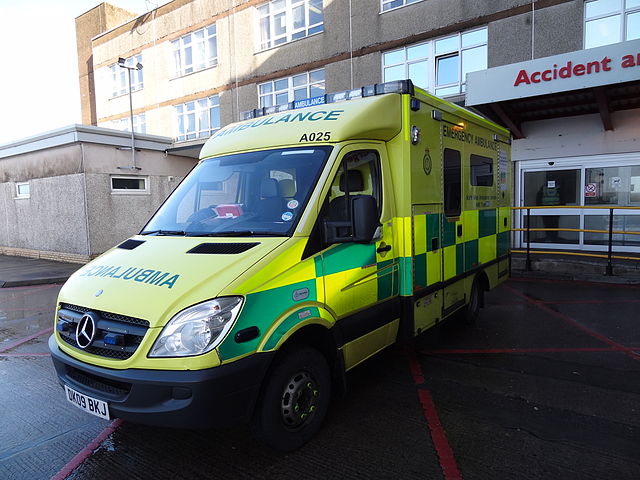When is an emergency not an emergency? What teeth Is it an emergency?
'999—Fire, police, ambulance? How can we help? ” This familiar phrase, often heard when dialing the UK emergency services number, was once a reassurance to make the call, but also a warning to identify the service you need and to avoid taking a moment to He made sure nothing went to waste. But in 2022, things will change and we will be entering a brave new world of health.
Britain's emergency services are in a desperate situation. In some areas, there is a risk that ambulances responding to 999 calls will be completely discontinued by August. The direct cause is said to be overcrowding of emergency personnel, with many patients suffering from acute illnesses that require the most urgent “blue light” ambulances. Mark Docherty, West Midlands Ambulance Trust Warn “''titanic for a moment'The tipping point was caused by the wards being full and ambulance colleagues having nowhere to transport patients. Late spring is historically an unusual time for hospitals to be crowded. Winter is over and so is flu season. So where are these patients in need of urgent care coming from and why now?
It is now common to see queues of ambulances forming outside the entrances of many hospital accident and emergency departments. Reports of patients dying or other patients dying at the scene of illness or injury due to delays in medical attention in An increasing number of ambulances are unable to provide necessary emergency treatment within hospitals. Crew members are constantly kept off the road as they must become the primary caregivers for patients for hours at a time until they can safely hand them off to doctors and nurses on hospital grounds.
The UK Government has just allocated £36.3 million to provide cutting-edge technology. new vehicle To increase the number of ambulance crews. Emergency workers will also be given body cameras to deter public violence. Patients will be encouraged to “sit if convenient” to relieve some of the pressure on ambulance space. In line with the NHS long-term plan, the government plans to convert 90% of its fleet to ultra-low and zero-emission vehicles by 2028. Staff will also be encouraged to use electric vehicles.
But is this the answer? Britain is giving Ukraine an older model ambulance, but some might be forgiven for having doubts as charity work begins in the country. While the Freemasons' generous donation of road and air ambulances, which has become increasingly well known, may be to be commended, the fundamental issue really lies in the vehicles and the trained crews who man them. Is it simply a lack of , or is there something more to it?
We're in the middle of summer, a time of year when we would normally hope to catch up on waiting lists for patients needing elective surgeries and treatments, but instead our hospitals are overwhelmed with acutely ill patients requiring intensive care. It's in why?
Half a million adults are currently on social care waiting lists and are struggling to access vital services due to severe staff shortages in care services. The number of people waiting for a care assessment has increased by 72% over the past year, bringing the total backlog to 506,301. Currently, social care prioritizes cases where abuse or neglect is recognized and discharges. According to a report published by the Association of Directors of Adult Social Services (ADASS): waiting for careduring the first three months of 2022, we were unable to provide nearly 170,000 hours of home care per week due to a shortage of caregivers. seven times The number has been increasing since spring 2021. The situation continues to worsen, with increasing numbers of people requiring care with increasingly complex needs.
NHS Long Term Plan 2019 make a plan A vision of a future where everyone is responsible for their own health. Home hospitals are the way forward. Virtual wards, remote monitoring, surveillance and biosensors will become the new normal. However, ADASS challenges this model, saying that making hospitals the center of resources without addressing care and support at home means that many people will end up worse off and end up needing hospital care. He points out that it means to become.
With ambulance services collapsing and disappearing, what are the plans for the future? Will we even need ambulances? Will they be autonomous and manned by robots? The NHS long-term plan includes “'' vehicles.safe mental health vehicleA specially trained mental health team will take patients to a new mental health hub that is currently being rolled out. But where does a standard ambulance take its occupants?
There are four priority categories for paramedics in the UK.
- Category 1 – Life-threatening – Response time 7 minutes
- Category 2 – Emergency call – Response time 18 minutes (stroke patients are sent to a specialized stroke unit)
- Category 3 – Emergency calls – 120 minute response time, may be answered from home
- Category 4 – Non-urgent calls – Response time is 180 minutes (3 hours). Callers may be provided with advice over the phone in lieu of dispatching an ambulance
This model is inherently questionable. Given the importance of the 'golden hour' in saving lives in emergencies, why are stroke patients relegated to Category 2?
Currently, patients can wait up to 12 hours for an ambulance and be stranded in an ambulance outside a hospital for another 12 hours. Some people die on the way or before the ambulance arrives. What is causing the sudden trend in 999 calls? How many of the people most urgently in need of “blue light” ambulance response have received the COVID-19 vaccine and are suffering from symptoms? Is there one? serious side effects?Does anyone in the system ask that or does anyone care? Cancer patients who require ambulance transport for treatment either never arrive for treatment, or even if they do arrive, The patient is forced to wait an anxious time for the patient to be picked up and returned home after the harsh treatment. This is clearly unacceptable and cruel.
As you look further, the layers of the problem keep peeling away. When is an NHS ambulance provider not actually the NHS? The NHS logo is used by many private companies, and in the hands of trained NHS staff. It gives an illusion to the public. This is not always the case as ambulance services are outsourced these days. One of the UK's largest private ambulance services, Falck UK Ambulance Servicehas repeatedly failed, and a major cancer hospital says the system has been in “disarray” since it was outsourced to Falk. What a relief that the Freemasons are busy donating new vehicles. We should all be grateful, right?
Far from the highest standards of emergency care we are accustomed to in the UK, there are currently many harrowing stories as a result of a broken system, including shared ambulances during lockdown, poorly trained staff and sloppy care. is emerging. The North East Ambulance Service in England currently Under investigation It comes after a whistleblower raised concerns about how the ambulance service is handling the coroner's trial. Were patient death records falsified or concealed?
Clearly, there are many problems with our ambulance service. But what other factors are contributing to this meteoric rise in “incidents”, deaths, and unacceptable long waits? This question should be directed to the people who run our hospitals. Why are all the beds occupied? Why aren't patients discharged? Will we be facing a summer of closed-up sleep ahead? Apparently so. Social care is on its knees as it struggles to find both caregivers and carers to look after the most vulnerable elderly who have nowhere to go and no one to look after them.
In the 2020-2021 reporting year, the Ombudsman in England alone received 2,033 complaints and inquiries relating to adult social care. This included 270 statements about independent care providers, the sector in which clients arrange and pay for their own care. As in all areas of casework, the Ombudsman made the following decisions last year: fewer complaints This was an increase compared to the previous year due to the disruption caused by the new coronavirus.
Many nursing homes have been forced to close during and after the coronavirus pandemic. However, due to a combination of declining occupancy rates and a decline in the number of individuals financing nursing care, some nursing homes are facing a crisis in which their incomes have declined and the cost of living continues to rise. This appears to be in response to a significant number of residents dying during the pandemic. Many people now wish to remain in their own homes rather than choosing the care home option. The concept of home hospitals seems to have arrived before we were aware of any major changes. As new ways to provide care at home using remote devices and biosensors mature, fewer patients will need to be transported to the hospital.
The National Health Service, the ambulance service and the social security sector are collapsing. One cannot function without the other. Until all three work in sync, we should be prepared for things to get much worse before they get better. Please wear your safety belt. It's going to be a tough ride in the ambulance.


